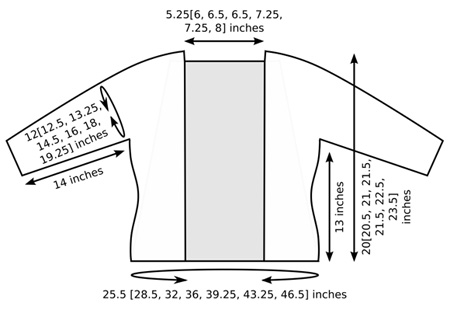

|
|
|
 |
I knit this cardigan for my holiday. It was designed to be
loose, casual and in a neutral color so
that I could wear it with everything. I like to pack light and
going to Florida, I didn’t want to bring more than one
warm cover up. |
|
|
|
SIZE |
|
FINISHED MEASUREMENTS |
|
MATERIALS Notions |
|
GAUGE |
|
PATTERN NOTES |
M1L (left-leaning increase): Insert left needle, from front to back, under strand of yarn which runs between last stitch on left needle and first stitch on right needle; knit this stitch through back loop. 1 stitch increased. M1R (right-leaning increase): Insert left needle, from back to front, under strand of yarn which runs between last stitch on left needle and first stitch on right needle; knit this stitch through front loop. 1 stitch increased. W&T (Wrap & Turn; worked in garter st): Instructions for the Backward Loop
Cast On can be found
here. Crochet Stitches:
|
|
DIRECTIONS Set-up Row [RS]: Kfb, place marker, kfb, k6[4, 2, 0, 0, 0, 0], kfb, place marker, kfb, k16[18, 20, 20, 22, 22, 24], kfb, place marker, kfb, k6[4, 2, 0, 0, 0, 0], kfb, place marker, kfb. 44[42, 40, 36, 38, 38, 40] sts. P 1 row. Divide Body from Sleeves: Work in stockinette st until work measures 2 inches from underarm, ending with a WS row. Waist Decrease Row [RS]: [K to 3 sts before marker, ssk,
k1, slip marker, k1, k2tog] twice, k to end. 72[82, 92,
104, 114, 126, 136] sts. Work 5 rows in stockinette st. Note: This sample was knit using a cotton-blend yarn which does not curl excessively in stockinette st. If you are working with an animal fiber yarn, you may wish to work the lower 2 inches of the body in garter st to prevent curling. Continue in stockinette st until work measures 13 inches from underarm or desired length. BO all sts. SLEEVES K 15[15, 15, 15, 11, 11, 7] rounds. Continue in stockinette st until sleeve measures 14 inches
from underarm or desired length. BO all sts. Work other sleeve in the same way. COLLAR K 1 WS row. Continue in garter st until collar measures 5.25[6, 6.5,
6.5, 7.25, 7.25, 8] inches. Be sure to
measure collar depth from picked-up sts
along front edge, not in short-rowed
section. |
|
FINISHING Make each button loop as follows: Use sl st to join yarn to edge, slightly above marker; work a crochet chain long enough to fit snugly around button; use sl st to join yarn to edge, slightly below marker; fasten off. Sew buttons to left front, opposite button loops. Sew one half of each snap to RS of left front band, near edge. Sew remaining half of each snap to corresponding positions on WS of right front band. |

|
| ABOUT THE DESIGNER |
|
Carol Feller is an independent knitwear
designer living in Cork, Ireland. Trained
as both an artist and a structural engineer,
she has found a real "home" in
knitting and design -- work which allows
her to combine the best of both those worlds.
As a busy mother of four, finding time
to design is not always easy, but she does
her best. |
|
Pattern & images © 2010 Carol Feller. Contact Carol |